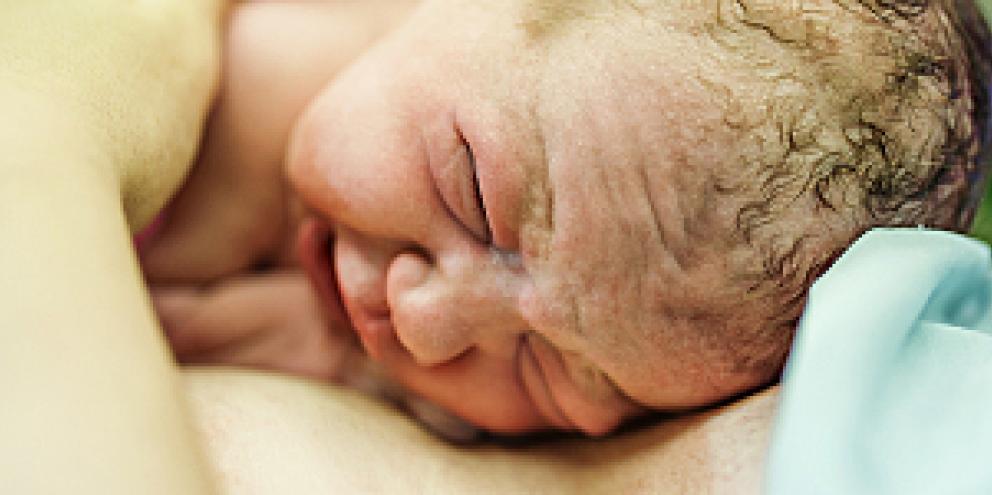
The transition from a warm womb to the open air of a labor and delivery unit can be jarring, with the difference between in-utero and environmental temperatures leaving infants vulnerable to hypothermia. Hypothermia raises the risk of hypoglycemia, respiratory distress, intraventricular hemorrhage, and even mortality.
However, with the right teamwork, processes, and technology, nurses can help newborns keep their temperatures just right: between 36.5°C to 37.5°C as recommended by Neonatal Resuscitation Program (NRP) guidelines. Using quality improvement (QI) projects in labor and delivery units is an effective way to ensure the critically important goal of neonatal normothermia is achieved.
Many labor and delivery units and NICUs have used the Plan-Do-Study-Act cycles of QI methodology to find problems in their thermal management processes—implementing and evaluating solutions after issues in the workflow have been identified.
Effective Ways to Keep Babies Warm
The most recent National Association of Neonatal Nurses (NANN) and NRP guidelines—along with evidence from numerous QI projects in L&D units and NICUs—offer several concrete practices to keep neonates normothermic. These immediate interventions are part of the golden hour protocol, which emphasizes the importance of prompt thermoregulation to improve neonatal health outcomes. Recommendations from the golden hour protocol include:
- Keep the newborn's environment warm. Maintain delivery and operating room temperatures between 26°C and 28°C. Use warm surfaces, such as thermal mattresses and pre-warmed incubators, to receive newborns.
- Keep the infant covered and cozy. Use warm blankets, caps, kangaroo mother care, and skin-to-skin contact when needed. Preterm infants also benefit from the use of polyethylene wraps promptly after delivery until they can be stabilized in an incubator.
Improving Everyday Thermoregulation Practice
When examining their thermal regulation processes, many L&D units and NICUs found concerningly high rates of hypothermia, with between 50% and 70% of infants hypothermic at admission. By identifying factors impeding thermal regulation best practices, rates of hypothermic admission can improve.
Here are recommendations L&D units and NICUs can implement, including case studies showing how these approaches and techniques have worked in real settings.
Examine the Environment
- Work with obstetrics and surgery staff to keep operating room temperatures from being too cold. Delivery and operating room temperatures should be between 78.8ºF and 82.4ºF (26ºC and 28ºC).
- Train staff on warming equipment and measures, such as prewarming the bed, polyethylene bags, use of skin temperature probes and thermal mattresses.
- Pay special attention to transfers and physical transitions between surfaces and equipment.
As reported in a study in The Israel Medical Association Journal, an Israeli team took this approach, increasing use of exothermic mattresses and occlusive wrappings, raising delivery rooms and operating room temperatures, and focusing on transitions between their L&D unit and the NICU—which were in separate buildings attached by an outdoor corridor. With these interventions, they achieved a significant reduction in hypothermia incidence, which was most profound for preterm infants.
Analyze Current Processes
- Ensure staff members are performing a quick and accurate assessment of temperature.
- Assess knowledge of and adherence to the recommended NANN, NRP, and golden hour protocols.
- Consider equipment training and staff education, logistics, and the use of checklists to improve the implementation of thermoregulatory measures.
Using these techniques, two separate teams were able to see significant results. A team in Seoul, Korea, as reported by the Korean Journal of Pediatrics reduced admission hypothermia rates from 71% to 45% and achieved a significant reduction in the incidence of pulmonary hemorrhage. This was after implementing a clustered care protocol and feedback checklist ensuring appropriate environmental measures.
A second team, located at the NYU Langone Hospital-Long Island, published a study in the Journal of Perinatology after managing to decrease NICU admission for hypothermia by more than 70%. They used intensive nursing education, a hypothermia algorithm, and visual tools to audit checklist adherence and adjust where needed.
Acknowledge Special Populations
- Preterm and low birth weight infants require different thermal interventions than term infants.
- Infants who are primarily kept in rooms with their mothers may be more susceptible to environmental temperature changes.
- Infants with perinatal asphyxia and risk for hypoxic-ischemic encephalopathy may benefit from lower temperatures and even therapeutic cooling.
Recognizing the special needs of preterm patients, a team at the University of Virginia published a study in the Journal of Perinatology about how they cut rates of hypothermia in preterm infants in half. How? By implementing a care bundle of increased operating room temperatures and use of exothermic mattresses and polyethylene wraps for its premature newborns.
Consider Technology Options
- Ensure thermometers, thermal mattresses, warmers, and incubators are functional and well-maintained.
- Ensure thermal monitoring of the infant to prevent hyperthermia.
- Assess staff's comfort with the use of all technology on a regular basis.
- Research and explore new technologies for measuring and maintaining normothermia, considering complementary use of both high and low-tech interventions.
- For instance, the newest incubators offer sensitive control mechanisms to minimize temperature swings and provide uniform heating during transitions.
A 2017 study in the Journal of Thermal Biology demonstrated the feasibility of using non-invasive infrared thermal imaging to monitor premature infants. This monitoring captured acute changes in temperature and perfusion, offering researchers and clinicians a new, invaluable thermoregulation tool.
Individualizing for Your Unit
In a study published by the Journal of Perinatology, a multidisciplinary team at the University of Vermont created and implemented thermoregulation guidelines tailored specifically for their unit. By increasing operating room temperatures, obtaining 10-minute axillary temperatures, and using exothermic mattresses for all term infants (polyethylene wraps for all preterm infants), they reduced hypothermia rates by 30%.
It is important to take these recommendations and individualize them for your unit's needs. When you take the time to study current best practices and technologies and assess them for how they might fit into your L&D and NICU's unique environment, processes, protocols, and patient population, you can optimally address one of the key issues in labor and delivery nursing and ensure that all of your newborn patients are kept healthy, safe, and warm.








